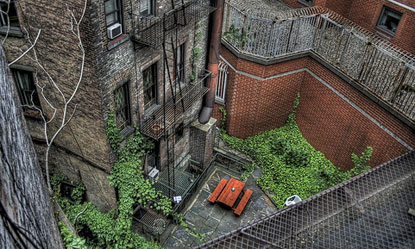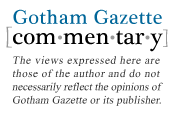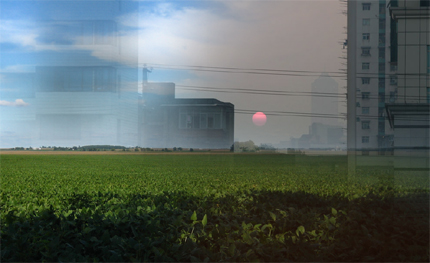An Unknown Urban Forest

It is often said that parks are the lungs of the city. But just as parks help clean the air and cool the city, so do an often neglected resource: the thousands of privately owned front and back yards of the city's rowhouses and apartment houses. The tools to green the city are right under our noses — and PlaNYC2030 and most of New York City's citizens are missing them.

While Mayor Michael Bloomberg's PlaNYC highlights and relies on the substantive and undeniable environmental benefits of publicly owned open space, privately owned public space is barely even on the city radar screen. As environmental concerns move front and center and urban open spaces are increasingly threatened, these back yards suddenly appear to be a valuable resource that we can no longer afford to disregard.
Environmental Benefits of Open Spaces
A groundbreaking 1996 study conducted by the U.S. Forest Service found that New York City trees remove over 2,000 tons of air pollution a year and store over 1.3 million tons of carbon annually. Think of trees actually cleaning the air, mitigating the pollution from cars and coal burning industries. These trees are the heavyweights of the global and the local environment -— to overlook their value is foolhardy and short-sighted.
Maintaining and planting trees also cools the ambient air during the hot summer months and is an effective mitigation strategy to impact the urban heat island effect -— a term used to convey the fact that urban, asphalt-laden centers can be as much as 10 degrees hotter than their surrounding, greener areas. If trees have the ability to make areas cooler, use of air conditioning is likely to decrease where trees are more abundant.
Other environmental benefits of tree planting and open spaces relate to the fact that permeable surfaces allow rain water to percolate slowly into our water table, instead of flooding our aging water treatment system — of particular concern because when the city's drains are overwhelmed by a quick influx of heavy rains, untreated sewage overflows into our waterways.
It is slowly seeping into our collective urban consciousness that cities cannot look to the Amazon forests only to combat global warming. We too must become ever more active stewards of our environment. Just as more of us are recycling, using compact florescent light bulbs and eschewing plastic bags (slowly!), public discourse should zero in on ways that encourages everyone — tenants, landlords and private property owners — to maximize the environmental benefits of existing open spaces.
New York City Back Yards
While “city backyards” might seem like an oxymoron, our city has a lot of them -- even in Manhattan. Wherever 19th century rowhouses survive —- Harlem, the upper east and west sides, Park Slope, East New York and many other areas -— significant, but hidden open spaces composed of adjoining back yards flourish. On the Upper West Side alone, these rear yards total over 100 acres of open space -— that is about one-eighth the size of the entire Upper West Side and almost 14 percent of the size of Central Park.
If we were to add up all the open spaces in private back and front yards in the entire city, we would find that there are many hundreds of acres of privately owned open spaces that are overlooked by individiduals and city planning and environment officials alike — and we can reason that these back yards have similar environmental benefits as the trees and open spaces in our parks. The lungs of the city are comprised of publicly and privately owned trees and open spaces, but air that is cleansed is shared by us all.
Soon, we might find out just how much these open spaces contribute to the city's climate.
LANDMARK WEST!, an Upper West Side community based preservation advocacy group, is partnering with Columbia University Center for Climate Systems Research and the City University of New York's Institute for Sustainable Cities to analyze the micro-climates in sample rowhouse blocks on the Upper West Side. This project will quantify the environmental benefits of rowhouse back yards. Just as it was important for the city to study publicly owned trees and open spaces before it devised its PlaNYC environmental initiatives, it is important to collect solid scientific data as a foundation on which to develop public policy with regard to privately owned open spaces, to maximize the potential environmental good that these back yards offer the city.
The findings of the LANDMARK WEST! partnership could also determine whether and to what degree these back yards reduce ambient air temperature, alleviating the urban heat island effect, and reduce air pollution, improving air quality. Other useful information, such as measuring permeable surfaces, will be gathered to calculate how much rainwater these backyard surfaces divert from New York City's water treatment system, thus reducing its burden (and associated costs) during peak rains.
PlaNYC Environmental Initiatives
If the city is serious about planting one million trees by 2030, it must also encourage preservation and maintenance of existing trees, be they on private property or public land. City agencies should not approve building permits without considering the environmental effects and all associated costs of demolition, and it should not approve rear yard additions and other building projects that destroy trees or reduce permeable surfaces without considering the associated environmental and economic costs.
Otherwise, the city will spend millions planting street trees in the neighborhood front yards, while trees in backyards are destroyed or die because property owners have not embraced the cultural shift that will be needed to maximize the environmental benefits of these hidden open spaces. A sustained commitment to the principles PlaNYC 2030 and extensive coordination within and between our many city departments and public and private citizens will be critical if the goals are to be realized.
Unfortunately, this coordination and commitment is already coming up short. Even the Parks Department is violating some basic tenets of PlaNYC. According to the New York Times, the department is seeking to cut down 14 trees at Union Square; on Randall's Island, an unspecified number of trees were felled to make way for sports fields and countless trees were also destroyed (some say more than 400) to make way for the new Yankee Stadium. Not only were these trees uprooted and killed, but the newly installed fields are made of synthetic turf, a material which increases temperatures markedly, violating yet another central tenet of PlaNYC. Making the internal PlaNYC contradictions even more apparent, asphalt was installed to replace pavements instead of using permeable pavement surfaces, as forward-thinking urban planners are doing. While there are myriad political impediments to some of the city environmental initiatives, some initiatives involve less money but a lot more coordination, commitment and imagination.
The city must assist community based projects — such as the LANDMARK WEST! Project — to quantify the environmental benefits of trees and open spaces in the city's back yards, to shed light and provide guidance to green these overlooked back areas. Imagine the possibilities if we nurture each little piece of open space we already have. The city will be a healthier —- and a more pleasant -— place to live.
Evan Mason is Special Projects Coordinator at LANDMARK WEST!, a non-profit community group working to preserve the best of the Upper West Side's architectural heritage from 59th to 110th Streets between Central Park West and Riverside Drive.
Back to the Sustainability Watch homepage
Â
Cleaning Up a Creek
On a waterway like Newtown Creek, one of the dirtiest in North America, progress must be measured in decades.
The creek is an open wound in the heart of New York City. Slowly flowing through Queens and Brooklyn before being blended by the tides into the East River, its waters carry oil slicks, floating trash, and billions of gallons of raw sewage in New York Harbor each year. Its shoreline is home to dozens of contaminated sites, decaying waterfront property, and one of the nation's largest underground oil spills. There is no natural space and only a single sliver of a park.

Surrounding neighborhoods—Greenpoint, East Williamsburg, Maspeth, Long Island City—have shouldered the pollution burden for a century. Whether by design or by destiny, Newtown Creek will serve as a test site for the initiatives proposed by Mayor Bloomberg in plaNYC 2030.
Tackling Contamination
One year into plaNYC, the view of Newtown Creek hasn't changed perceptibly. The lack of progress in the field underscores the monumental nature of the challenge. While plaNYC did not address Newtown Creek directly, many of its initiatives, if carried through, would bode well for its restoration. The mayor's initiative presented citywide goals that would speed up the remediation and redevelopment of contaminated sites, create new parks and green spaces and address the problem of raw sewage in the harbor.
On contaminated sites, the mayor proposed eleven initiatives aimed at fast-tracking cleanups, increasing public involvement, and streamlining redevelopment. Newtown Creek has seen progress on the public involvement front. The Greenpoint Manufacturing Design Center, Riverkeeper, and the Newtown Creek Alliance were recently awarded a $625,000 grant from the New York's Department of State for a community-driven brownfields study—an application the city strongly supported. The study will lay out a vision for the creek and leverage money and support for cleanups.
On open space, the mayor proposed seven initiatives aimed at increasing the amount of green cover around the city. In 2007, the city opened the first ever park along the creek—this one at the Newtown Creek sewage plant—and is set to open up a second on the Greenpoint waterfront in 2008.
The Sewage Issue
On the problem of raw sewage, the mayor proposed ten initiatives for improving harbor water quality, yet on this important issue the outlook for Newtown Creek remains clouded. Raw sewage has plagued Newtown Creek -- as it has throughout the harbor -- because of the city's outmoded sewer system, which mixes stormwater from the street with sewage from buildings. A tenth-of-an-inch of rain can overload the system, forcing the combined stream to overflow untreated into the harbor, severely impacting water quality.
The problem disproportionately affects Newtown Creek because it no longer has a natural flushing mechanism. The mayor set a goal to open 90 percent of city's tributaries to human contact by improving treatment systems and expanding green cover across the city in an effort to keep stormwater from ever entering the sewer system. This seemingly ambitious goal, however, would only open harbor tributaries like Newtown Creek, to boaters -- kayakers, swimmers and waders must still beware. A truly ambitious goal of opening up one hundred percent of the harbor to safe human contact would have served as a powerful lever for change, and it would have demonstrated that the city was prepared to hold itself more accountable.
A Cleaner Future
Despite this shortcoming, the future for Newtown Creek looks brighter as a result of plaNYC 2030.
Ten years ago, City Hall shunned talk of environmental sustainability. Today, we have a Mayor with a vision and a forum for public input. The hard work is ahead. The success of the plaNYC initiatives on Newtown Creek as well as other tributaries citywide will depend on public support for a bold environmental agenda and an engaged City Hall and City Council.
In the short-term, the mayor must demonstrate his ability to break down institutional barriers and archaic mindsets that had hastened the decline of the environment. In the long-term, the success of PlaNYC 2030 will depend on the political endurance of the city's future leadership, so that today's momentum is not wasted.
Basil Seggos is the Chief Investigator and Hudson River Program Director at Riverkeeper.
Back to the Sustainability Watch homepage
Â
The Dirty Side of Biodiesel

of greenhouse gases and toxic air emissions.
With oil prices at an all time high, a quagmire in Iraq that more than one pundit has attributed to our massive energy appetite and a general consensus on the threat posed by global warming, dumping fossil fuels in favor of "renewable" ones made from domestically grown crops sounds like a win-win situation. In this light, Councilman James Genarro's bioheat bill, which proposes we add vegetable-based biodiesel to traditional diesel heating oil supplies in New York City, appears to be sound policy. Unfortunately, biodiesel has an oft overlooked dirty side and few of its touted benefits hold up under closer scrutiny.
Bioheat proponents claim that substituting biodiesel for petroleum can curtail oil imports, improve air quality and reduce greenhouse gas emissions.
In reality, a biodiesel mandate would encourage environmentally destructive farming practices, have no impact on foreign oil consumption, increase greenhouse gas emissions, drive up food prices and devour millions of dollars in taxpayer subsidies.
As for the improved air quality claims, it's a false comparison. The choice is not between biodiesel and New York City's current high sulfur diesel heating oil standards. The choice is between biodiesel and ultra low sulfur diesel -- a new fuel standard that shares a similarly positive air quality profile with biodiesel. To Councilman Gennaro's credit, the better half of his bill supports replacing high sulfur diesel heating oil with ultra low sulfur diesel.
What's at Stake?
A million households and thousands of businesses in New York City consume approximately 500 million gallons of high sulfur diesel heating oil annually. Because the sulfur content of fuels is directly related to emissions of fine particulate matter, heating oil ranks as the largest source of particulate matter in the city. Able to penetrate into the deepest portions of the lungs, this particulate matter contributes to premature death from heart and lung disease, cardiac arrhythmias, heart attacks, asthma attacks and bronchitis.
A recent report released by the energy consulting firm Synapse Energy Economics confirms that by mandating ultra low sulfur diesel heating oil for New York City, we can reduce particulate emissions by more than two-thirds. The report also describes how ultra low sulfur diesel improves furnace efficiency, decreasing fuel consumption and reducing maintenance. That means that by heating our homes with ultra low sulfur diesel we can save money while reducing greenhouse gas and particulate emissions.
Squeezing Renewable Energy from Non-Renewable Resources
Biodiesel can be refined from a wide variety of vegetable oils and animal fats, but in the U.S. subsidies and tariffs make soybean oil the dominant feedstock. Soybeans may be a renewable resource, but America's industrial-scale farms devour and destroy enormous quantities of non-renewable and irreplaceable resources.
Powering the machines that plow, plant, harvest, cast fertilizers, spray pesticides and pump irrigation is energy intensive. The fossil fuels consumed by on-farm operations release significant quantities of greenhouse gases and toxic air emissions.
Adding to soybean agriculture's formidable fossil fuel tally, large amounts of natural gas are needed to produce the nitrogen based fertilizers that promote their growth. These fertilizers break down in fields releasing nitrous oxides -- a global warming agent hundreds of times more potent than carbon dioxide. When these fertilizers leach from farm fields they poison drinking water and ravage marine ecosystems. Run-off from Midwestern farm fields ends up in the Gulf of Mexico where it contributes to a New Jersey-size "dead zone" almost entirely absent of marine life.
Making matters worse, the U.S. Department of Agriculture reports that 91 percent of the U.S. soybean acreage planted in 2007 was genetically engineered to tolerate herbicides, a development that has boosted glyphosate herbicide applications several fold. Glyphosate, a powerful weed killer, is the third most common cause of pesticide illness in farm workers and research indicates that exposure is linked to rare cancers, miscarriages and premature births.
If passed, Genarro's bioheat bill will force New Yorkers to consume approximately 100 million gallons of biodiesel annually by 2013. With an average yield of 58 gallons of biodiesel per acre of soybeans, heating our homes and businesses would require approximately 1.7 million acres of soybeans, which in turn, according to figures garnered from a 1998 Department of Energy report, would require:
Soybeans may be green, but growing them is most certainly not.
Greenhouse Gas Emissions and Food Prices Rise
The U.S. is on track to produce 3.3 billion gallons of biodiesel in 2009 -- a quantity of fuel that would consume nearly every acre of U.S. soybeans, yet meet only 6 percent of our diesel demand. That 6 percent is not going to secure our energy independence, but it will increase greenhouse gas emissions and raise food prices.
Every acre of food diverted for fuel requires that another acre be planted to grow the missing food, and when land is cleared for cultivation, it releases up to 420 times more carbon than the fossil fuels it displaces. Low-income countries offer cheap land and labor, and tropical crops, such as palm, can yield eight times more oil per acre than soybeans. If we continue to mandate the consumption of biodiesel, we will exhaust domestic soybean acreages, and production will then shift to the tropics. An analysis by the Clean Air Task Force finds Europe's appetite for biodiesel is already registering in Indonesia and Malaysia, where thousands of acres of forest have been cleared to make way for palm oil plantations -- destroying wildlife habitat and releasing millions of tons of greenhouse gases in the process.
Switching land from food to fuel also raises food prices. In the U.S., demand for corn based fuels has contributed to a dramatic spike in the price of corn. This is also pushing up the cost of corn-intensive foods such as dairy, eggs and meat, which is pinching New Yorkers pockets. In Mexico, the high price of corn, which threatens the food security of millions living on less than a dollar a day, has sparked widespread protests.
Our Tax Dollars at Work
Hundreds of government programs have been created to support virtually every stage of production and consumption relating to biodiesel. Everyone from soybean farmers to biodiesel distributors get handouts -- compliments of the taxpayer. According to the Global Subsidies Initiative, every year grants, tax breaks, cheap credit and regulatory mandates funnel hundreds of millions of dollars into promoting biodiesel, doling out around $2 for every gallon consumed.
Yet despite these massive subsidies, biodiesel is still not competitively priced against ultra low sulfur diesel. Or at least it wasn't until the recently passed state budget allotted another handout to agribusiness: the bioheat tax credit. Taxpayers should now be prepared to shell out another 20 cents per gallon to subsidize the biodiesel used to heat homes in the state.
Heating our homes with biodiesel would result in serious consequences for our health and the environment. There is no reason why New Yorkers should bear these costs when an easy solution is at hand.
By simply switching to ultra low sulfur diesel heating oil, a fuel standard already mandated for on-road vehicles and New York City ferries, we can dramatically improve the quality of the air we breathe daily while reducing oil consumption and greenhouse gas emissions through improved furnace efficiency. And we can do it without depending on taxpayer subsidized, unsustainable and environmentally destructive biodiesel.
Michael Heimbinder is Executive Director of Habitatmap, a Brooklyn-based environmental health justice non-profit.Â





